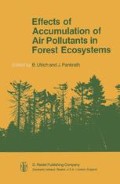Abstract
The nature of soil acidity as well as measures of the capacity and the intensity terms are discussed. According to the proton buffer reactions occuring in soils, buffer ranges are distinguished. They are defined by pH values. Forest soils on limestones which should be in the calcium carbonate buffer range, acidify under the influence of acid deposition as soon as the fine earth is free of calcium carbonate. The same may be true for soils staying in the silicate buffer range if the rate of acid load exceeds the rate of acid buffering by base cation release during silicate weathering. From existing data on the rate of acid deposition in Central Europe, it is concluded that soils staying in the cation exchange buffer range should have lost considerable amounts of exchangeable Ca due to acid deposition since beginning of industrialization. The resilience of the ecosystem becomes very limited if the soil stays with all major horizons in the aluminium or even in the iron buffer range. The iron buffer range is characterized by podzolization.
Access this chapter
Tax calculation will be finalised at checkout
Purchases are for personal use only
Preview
Unable to display preview. Download preview PDF.
References
Blume, H.-P. (1981): Berliner Naturschutzbl. pp.713–715
Butzke, H. (1981): Forst- u. Holzwirt 36 PP. 542–548
v. Zezschwitz, E. (1982): Forst- u. Holzwirt 37pp. 275–276
Wittmann, O. (in press): Untersuchungen zur Ermittlung der aktuellen Bodenversauerung in Bayern. Bayer.Geol.Jahrb.
Ulrich, B. (1981): Z.Pflanzenernähr.Bodenk. 144, pp. 289–305
van Breemen, N. and W.G. Wielemaker (1974): Soil Sci.Soc. Amer.Proc. 38, pp. 55–66
Ulrich, B., U. Steinhardt und A. Müller-Suur (1973): Göttinger Bodenkdl.Ber. 29, pp. 133–192
Johnson, N.M., Ch.T. Driscoll, J.S. Eaton, G.E. Likens and W.H. McDowell (1981): Geochimica et Cosmochimica Acta 45, pp. 1421–1437
Schwertmann, U. and M.L. Jackson (1964): Soil Sci.Soc.Amer. Proc. 28, pp. 179–183
Meiwes, K.J. (1979): Göttinger Bodenkdl.Ber.60, pp. 1–108
Mevius, W.: Reaktion des Bodens und Pflanzenwachstum. Freising und München, Datterer
Ellenberg, H. (1958): In W. Ruhland (ed.): Handbuch der Pflanzenphysiologie IV, pp. 638–708, Springer, Berlin
Foy, CD., R.L. Chaney and M.C. White (1978): Ann.Rev.Plant Physiol. 29, pp. 511–566
Süchting, H. (1948): Z.Pflanzenernähr., Düng.,Bodenk. 87, pp. 193–218
Süchting, H. (1943): Allgem.Forst- u. Jagdztng. 119, p.34
Nair, V.D. and J. Prenzel (1978): Z.Pflanzenernähr.Bodenk. 141, pp. 741–751
Driscoll, Ch.T. (1980): Chemical characterization of some dilute acidified lakes and streams in the Adirondack region of New York State. Ph.D.thesis Cornell University
Mayer, R. und H. Heinrichs (1981): Z.Pflanzenernähr.Bodenk. 144, pp. 637–646
Ellenberg, H. (1939): Mitt.Florist.Soziol.Arb.gem. Niedersachsen 5, pp. 3–135
Bache, B.W. (1982): The implications of rock weathering for acid neutralization. In “Ecological Effects of Acid Deposition”, series PM, Swedish National Environment Protection Board
Author information
Authors and Affiliations
Editor information
Editors and Affiliations
Rights and permissions
Copyright information
© 1983 D. Reidel Publishing Company
About this chapter
Cite this chapter
Ulrich, B. (1983). Soil Acidity and its Relations to Acid Deposition. In: Ulrich, B., Pankrath, J. (eds) Effects of Accumulation of Air Pollutants in Forest Ecosystems. Springer, Dordrecht. https://doi.org/10.1007/978-94-009-6983-4_10
Download citation
DOI: https://doi.org/10.1007/978-94-009-6983-4_10
Publisher Name: Springer, Dordrecht
Print ISBN: 978-94-009-6985-8
Online ISBN: 978-94-009-6983-4
eBook Packages: Springer Book Archive

